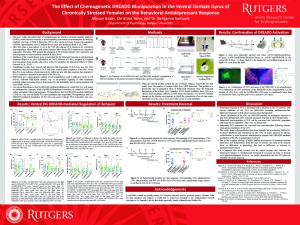Bazer, Allyson: The Effect of Chemogenetic DREADD Manipulation in the Ventral Dentate Gyrus of Chronically Stressed Females on the Behavioral Antidepressant Response
Listen to the audio presentation
Title: The Effect of Chemogenetic DREADD Manipulation in the Ventral Dentate Gyrus of Chronically Stressed Females on the Behavioral Antidepressant Response
Name: Allyson Barzer
Major: Psychology
School affiliation: Honors College, School of Arts and Sciences
Programs: Aresty – Research or Conference Funding Recipient
Other contributors: Benjamin Samuels, Christine Yohn, Sandra Ashamalla, and Debbie Ma
Abstract: Major Depressive Disorder is a psychiatric disorder that affects millions, with only 1 out of 3 patients attaining remission after treatment with a selective serotonin reuptake inhibitor. 5-HT1A receptors (a Gi-coupled inhibitory receptor) on mature granule cells in the dentate gyrus are necessary for the behavioral effects of antidepressant treatment. Because inhibition of DG GCs is necessary for the response to antidepressant treatment, we assessed whether direct inhibition of GCs in the ventral DG mimicked antidepressant treatment. We show that Gi-DREADD-mediated inhibition of the ventral DG results in a decrease in negative valence behaviors, like what is seen after chronic antidepressant treatment. We also assessed whether direct inhibition or stimulation of GCs in the ventral DG could alter response to antidepressant treatment. We show that Gi-DREADD-mediated inhibition of the ventral DG results in the conversion of non-responders to fluoxetine (an antidepressant; FLX) treatment into responders, while Gq-DREADD-mediated stimulation results in conversion the of responders to FLX treatment into non-responders. Taken together, these data suggest that inhibition in the ventral DG is necessary for the antidepressant response and illustrate that it is possible to bidirectionally alter the behavioral response to FLX treatment.
